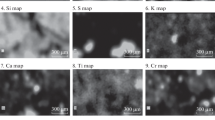Abstract
Ordinary chondrites are the most frequently found type of meteorites (about 85% of all meteorites found). There are three types of ordinary chondrites: H, L and LL. They contain various amounts of iron (type H - high amount of iron, type L– low amount of iron, type LL– low amount of iron and low amount of metal). Typical Mӧssbauer spectrum of ordinary chondrite is composed of doublets associated with olivines and pyroxenes and sextets associated with troilite and FeNi alloy (such as kamacite and taenite). In 2019 Warsaw group elaborated a new method of classification of ordinary chondrites using the results of Mössbauer spectroscopy. This method, called 4M method, consists in calculating the similarity of the investigated sample to particular types of ordinary chondrites based on percentage of Mӧssbauer spectroscopy areas of four basic mineral phases: olivines, pyroxenes, metallic components, and troilites. The aim of our current study was to verify the hypothesis that the thickness of the investigated sample of ordinary chondrite has no effect on percentages of Mӧssbauer spectral areas associated with four main mineral phases present in ordinary chondrites. The results of our experimental study confirmed this hypothesis.






Similar content being viewed by others
Data availability
Not applicable.
References
Lauretta, D.S., McSween, H.Y., Jr: Meteorites and the Early Solar System II. University of Arizona Press (2006)
Hutchison, R.: Meteorites: A Petrologic, Chemical and Isotopic Synthesis. Cambridge University Press (2004)
Herr, W., Skerra, B.: Mössbauer spectroscopy applied to the classification of stone meteorites. In: Millman. P.M. (ed) Meteorite Research. Astrophysics and Space Series. Science Library, vol. 12, pp. 106–122. D. Reidel Pub. Co, Dordrecht.) (1969)
Gałązka-Friedman, J., Woźniak, M., Bogusz, P., Jakubowska, M., Karwowski, Ł., Duda, P.: Application of Mössbauer spectroscopy for classification of ordinary chondrites–different database and different methods. Hyperfine Interact. 241, 11 (2020). https://doi.org/10.1007/s10751-019-1661-0
Gałązka-Friedman, J., Woźniak, M., Duda, P., Rzepecka, P., Jakubowska, M., Karwowski, Ł.: Mössbauer spectroscopy—a useful method for classification of meteorites? Hyperfine Interact. 238, 11 (2017). https://doi.org/10.1007/s10751-017-1439-1
Bogusz, P., Brzózka, K., Górka, B., Szumiata, T., Woźniak, M., Gałazzka-Friedman, J.: Classification of meteorites — Mössbauer comparative studies of three ordinary chondrites measured in different laboratories. Acta Phys. Pol., a. 134, 1070–1075 (2018)
Woźniak, M., et al.: Application of Mössbauer spectroscopy, multidimensional discriminant analysis, and mahalanobis distance for classification of equilibrated ordinary chondrites. Meteorit Planet Sci. 54, 1828–1839 (2019)
Gałązka-Friedman, J., Jakubowska, M., Woźniak, M., Bogusz, P., Karwowski, Ł., Duda, P.: 4 M method– new application of Mössbauer spectroscopy to classification of meteorites. How it Works? Hyperfine Interactions. 242, 55 (2021).https://doi.org/10.1007/s10751-021-01771-1
Jakubowska, M., Gałązka-Friedman, J., Woźniak, M., Bogusz, P., Karwowski, Ł., Duda, P.: Can Mӧssbauer methods of classifying ordinary chondrites help to identify non-representative samples of these meteorites? Hyperfine Interact. 242, 50 (2021). https://doi.org/10.1007/s10751-021-01779-7
Gałązka-Friedman, J., Jakubowska, M., Bogusz, P., Brzózka, K., Grabias, A., Idczak, R., Konieczny, R., Szumiata, T., Woźniak, M., Maslan, M., Karwowski, Ł.: How Mössbauer spectroscopy can be of value to industry to select extraterrestrial objects for natural resources. Hyperfine Interact. 243, 28 (2022). https://doi.org/10.1007/s10751-022-01808-z
Kuzmann, E., Nagy, S., Vértes, A., Weiszburg, T.G., Garg, V.K.: Geological and mineralogical applications of Mössbauer Spectroscopy. In: Vértes, A., Nagy, S., Süvegh, K. (eds.) Nuclear Methods in Mineralogy and Geology, pp. 285–376. Plenum Press, New York (1998)
Mössbauer, R.L., Wiedemann, W.H.: Kernresonanzabsorption Nicht Doppler-Verbreiterter Gammastrahlung in Re187. Z. Phys. 159, 33–48 (1960)
Vértes, A.: In: Korecz, L., Burger, K. (eds.) Mӧssbauer Spectroscopy. Akadémiai Kiadó, Budapest (1979)
Ruby, S.L., Hicks, J.M.: Line shape in Mössbauer Spectroscopy. Rev. Sci. Instrum. 33, 27–30 (1962)
Rancourt, D.G., McDonald, A.M., Lalonde, A.E., Ping, J.Y.: Mössbauer absorber thicknesses for accurate site populations in Fe-bearing minerals. Am. Mineral. 78, 1–7 (1993)
Lagarec, K., Rancourt, D.G.: Recoil: Mössbauer Spectral Analysis Software for Windows, Version 1.0. Department of Physics, University of Ottawa, Ottawa (1998)
Funding
None.
Author information
Authors and Affiliations
Contributions
All authors participated in the data analysis, M.J., K.B., M.W. J.G-F wrote the main manuscript text and M.W. prepared figures. All authors reviewed the manuscript.
Corresponding author
Ethics declarations
Ethical approval
Not applicable.
Competing interests
The authors declare no competing interests.
Additional information
Publisher’s Note
Springer Nature remains neutral with regard to jurisdictional claims in published maps and institutional affiliations.
Rights and permissions
Springer Nature or its licensor (e.g. a society or other partner) holds exclusive rights to this article under a publishing agreement with the author(s) or other rightsholder(s); author self-archiving of the accepted manuscript version of this article is solely governed by the terms of such publishing agreement and applicable law.
About this article
Cite this article
Jakubowska, M., Brzózka, K., Woźniak, M. et al. The influence of sample thickness on results of Mössbauer spectroscopy of ordinary chondrites and their classification. Hyperfine Interact 245, 3 (2024). https://doi.org/10.1007/s10751-024-01847-8
Accepted:
Published:
DOI: https://doi.org/10.1007/s10751-024-01847-8



